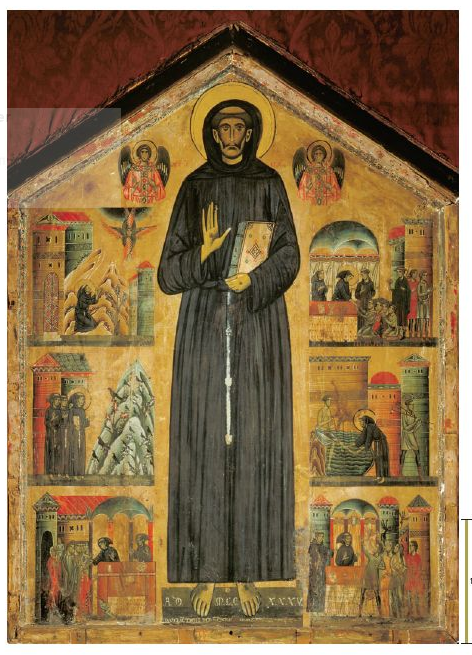
|
|
Tittle: Saint Francis Altarpiece. Century: 1235. 13th century Artist: Bonaventura Berlinghiere Movement/Culture: Byzantine Location: San francesco, Pescia, Italy Signifficance: He displays the stigmata, which are marks resembling christ's wounds. His use of gold leaf, the angels and their lack of modeling reveal his byzantine roots. Also the figures are flat and spiritual. |
| |
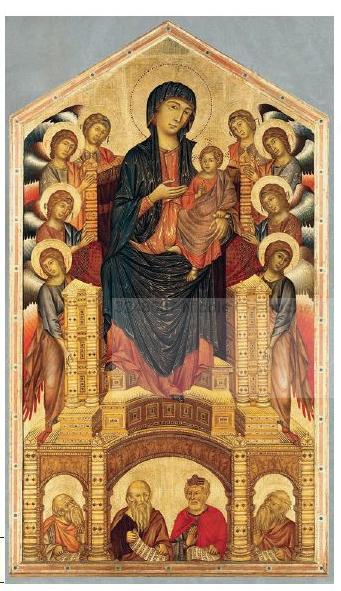
|
|
Tititle: Madonna Enthroned with Angels and Prophets. century: 1280-1290Artist: CimabueMovement:Location: Santa Trinita, Florence, Italy. He is moving away form the byzantine style. he uses model from byzantine style but he creates space by overlapping the angels and the virgin. the prophets at the bottom looking up and out reinforce the sense of depth. |
| |
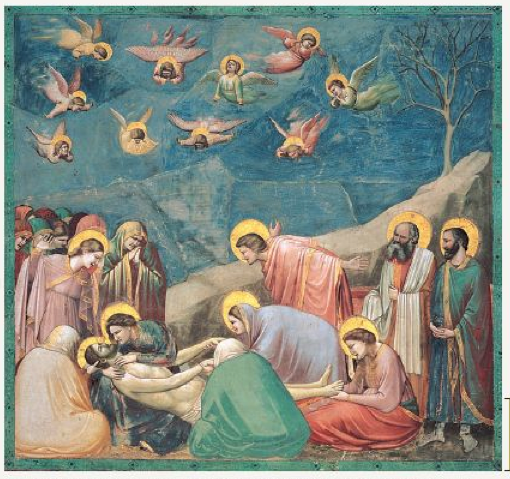
|
|
..Tittle: LamentationArtist:Gioto di BondoneCentury: 14th CenturyMovement: ?Location: Arena Chapell, Padua, Italy. Significance: this is where you start to see more life-like rendering. Theres is more emotion in the faces, and the angels are boldly foreshortened. this is also the first time backs of people have been painted and shown to the eye. his use of the the diagonal landscape directs eh viewer to the main scene which is the death of christ. |
| |
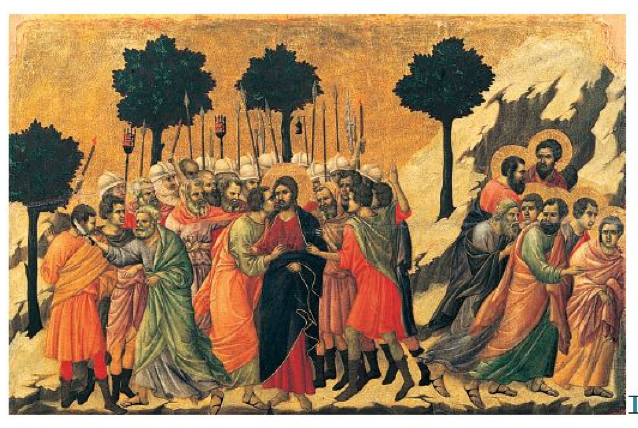
|
|
Tittle: betrayal of JesusArtist: DuccioCentury: 14th centurymovement/culture: sieneselocation: Siena Cathedral.the bodies are not that flat frontal shape anymore. Their drapery was more believable. The use of Landscape in a painting. First time where you start to see the depiction of human emotion. |
| |
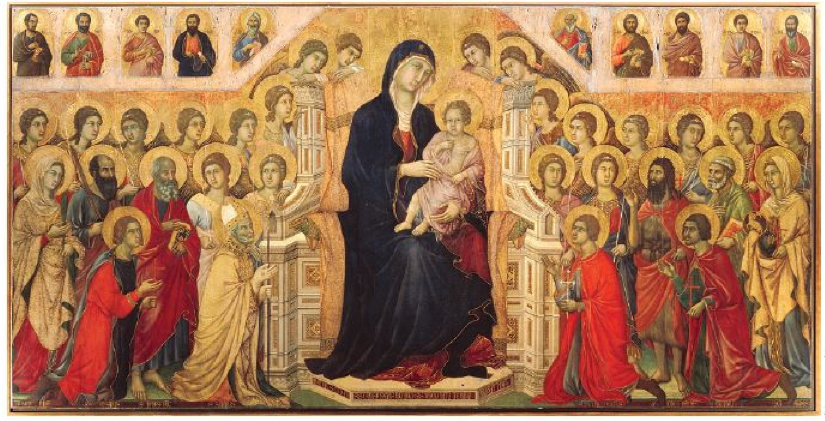
|
|
.Tittle: Virgin and child enthroned with saint. Artist: Duccio di Bunoniesegnacentury: 14th centurymovement/culture: Sienese location: Siena Cathedral, ItalySignificance: his used formality and symmetry from byzantine tradition but he relaxed the rigidity and frontality of the figures, he made them more human and gave each figure more individuality in their faces. also the drapery was more softened. Unlike Cimabue's his angels show more personality and even tho they are still overlapped they have their own space. |
| |
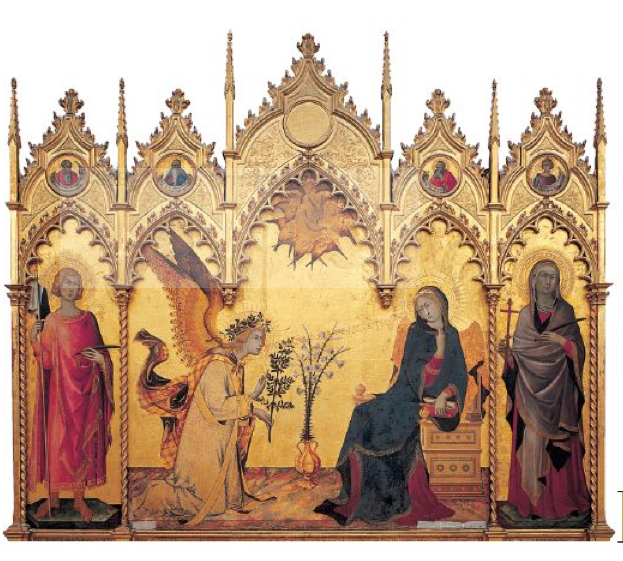
. |
|
tittle: AnnunciationCentury: 14th Artist: Simone Martini and Lippo MemmiMovement: SieneseLocation: Siena Cathedral, Siena, ItalySignif: this shows elegant shapes and radiant color and spaceless setting. He shows the angel Gabriel as he has just alighted, his wings are still beating. his golden gown shows his celestial realm. The virgin is shown as an upper class woman, shes reading her book, like a nice young lady from that time would. and puts it down when gabriel arrives. theres a great interest in reality. |
| |
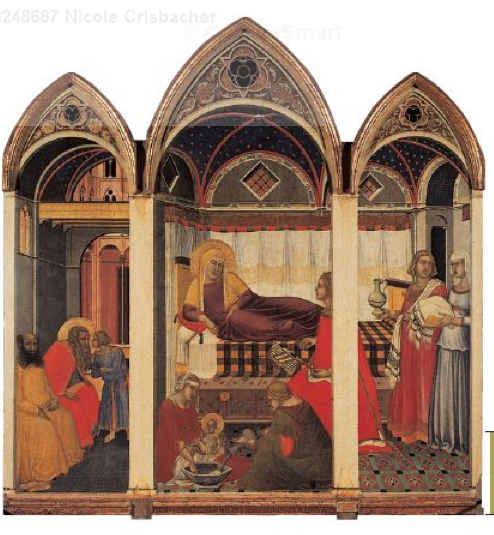
. |
|
Tittile: Birth of the Virgin.Century: 14th centuryartist: Pietro LorenzettiMovement: SieneseLocation: from altar of Saint Savinus, Siena Cathedral, Siena, Italy.Signig: He created architectural members that divided tha panel and made them look like they extend back into space. A good way to depict 3-dimensional space. It also shows a typical 14th century upper-class italian home. |
| |
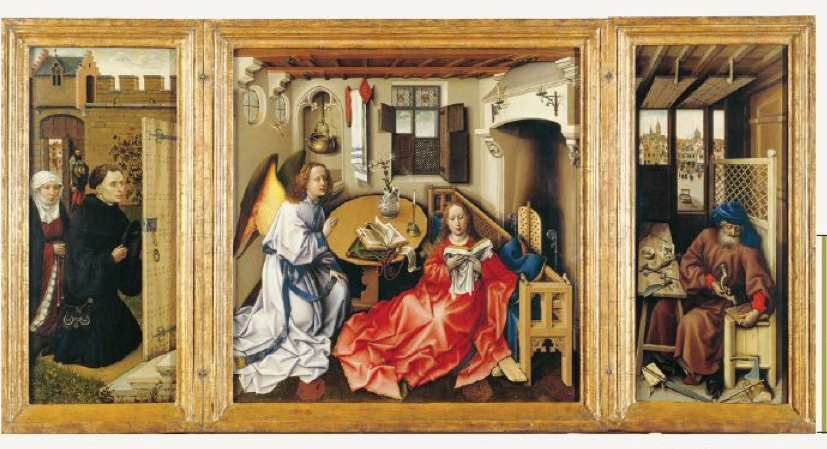
. |
|
Tittle: Mester of Flemalle, Merode Altarpice (open) Century: 15th Artist: Robert Campin.Movement: Beginning of protestant? Location: MET (cloisters) Signf: theres certain items in the room that symbolize the virgins purity, like the lilies, the book, the towels, the fire screen etc. in the right panel joseph is making a mousetrap, symbolizing christ as a bait to catch the devil. to the left panel are the donor and the donor's wife. the closed garden shows mary's purity. |
| |
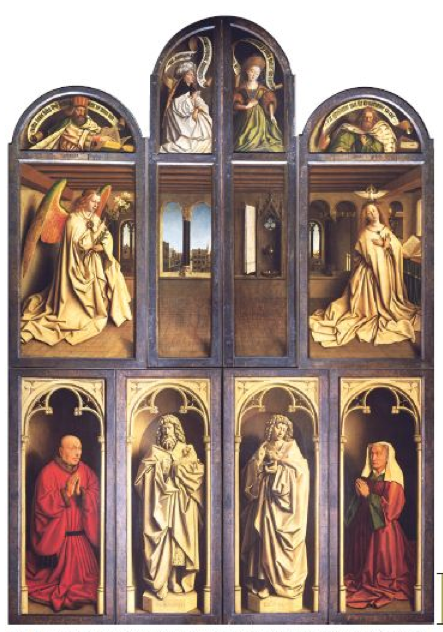
. |
|
tittle: Ghent Altarpiece. (closed)century: 15th centuryArtist: Jan Van EyckMovement:Saint Bravo Catherdral, Ghent, Belgium.Signf: There is a lot of linear perspective and shading which emphasizes the frame more. the center register show a window with a view of a flemish town. Top reister shows Old Testament Profits: (L) Zachariah, (R) Micah (C) Sibyls. Center register shows angel gabriel and the virgin.the bottom register shows the Donor, statue John the baptist, statue of John the Evangelist, and the donor's wife. the donors gaze at them piously
|
| |
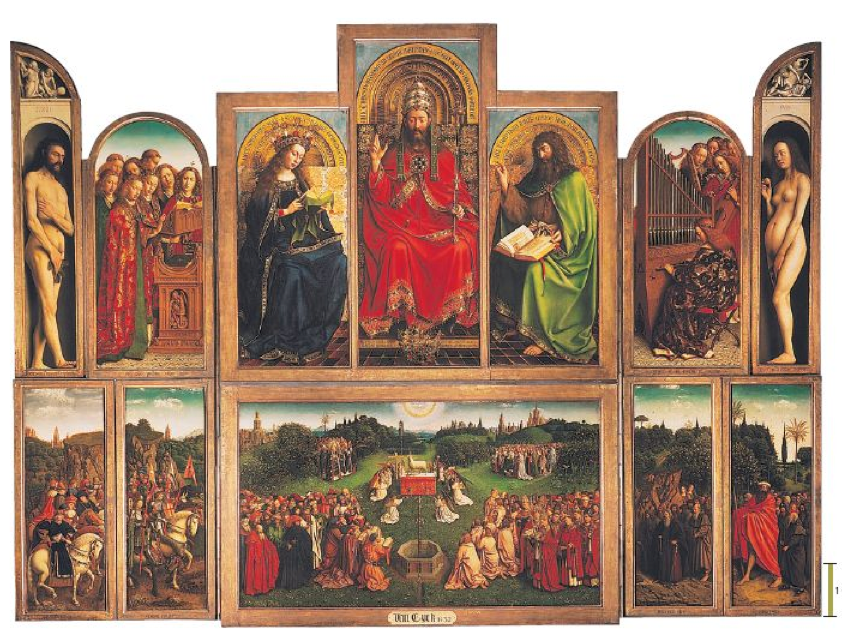
. |
|
tittle: Ghent Altarpice (Open)Century: 15th centuryArtist: Jan Van EyckMovement:Location: Saint Bravo cathedral, Ghent, Belgium. Signf: This painting shows the Salvation from the original sin of Adam and Eve. The top register shows (R) Adamn, the a choir of angels, the Virgin Mary, God the Father, John the Baptist. a choir of angels and Eve. the bottom register show the Lamb of God in the middle overseen by the Holy Spirit, in which communities of saints come from every corner. This symbolizes the sacrifice of god's only son to safe humanity, and shows how big god's love is. (L) prophets (L)background holly confessors. (R) 12 apostles, Martyrs in red ropes. Saints and Popes. (R) background Virgin Martyrs. |
| |
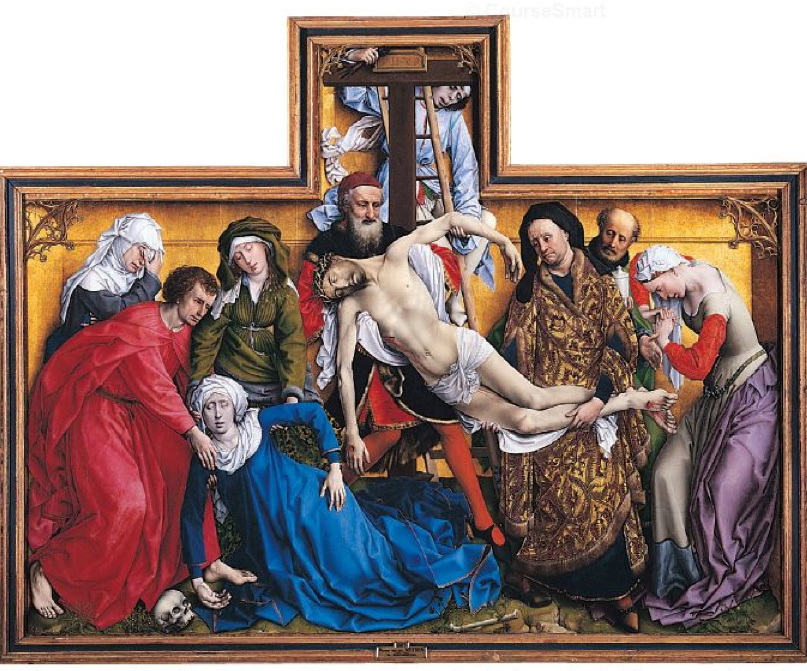
. |
|
tittle: DepositionCentury: 15th Artist: Rogier Van Der WeydenMovement:Location: Notre-Dame hors-les-murs, Louvain, Belgium. Signfi: Instead of making a landscape Rogier put the figures in a compressed shallow stage. The similar poses of Christ and Mary unify the composition. Lateral movements gives the group a compositional unity. There is so much more emotion in the depiction of the faces. the corners of this painting in top resemble gothic architecture. |
| |

. |
|
Tittle: Last SupperCentury: 15th centuryArtist: Dirk BoutsMovement: Location: Saint Peter's , Louvain, Belgium. Signf: Is one of the earliest Northern European paintings to demonstrate use of vanishing point to create perspective. He showed christ as a priest performing a ritual, the consecration of the Eucharistic wafer. It doesnt show the main focus of the supper which is Judas' betrayal, like other paintings. And he included 4 servants, which are most likely portraits of the commissioners. his is the last painted piece of the Last Supper |
| |

.. |
|
Tittle: January, from Les Tres Riches Heures du Duc de
Berry.
Century: 15th century
1400s
Artist: Limbourg Brothers
(Pol, jean, Herman)
Movement: Early
renaissance
Locaton: France.
Signif: they
expanded the illusionistic capabilities of illumination. This depicts a new
year’s reception court.
The duke is the bottom
right in blue rope, the fire screen behind him almost looks like a halo. They
wanted him to look like a great man. In the top there is a representation of
the zodiac sign which varies depending on the month.
|
| |

.. |
|
Tittle: October from Les Tres Riches Heures du Duc de Berry.
Century:
1400s 15th century
Artist:
Limbourg Brothers (Pol, Jean, Herman)
Movement:
early renaissance.
Loction:
France
Signif:
The peasants working in the land are not depicted as sorrow and sad people.
This was just a way to flatter the duke as a compassionate master. The Louvre
is in the back which is where the king resides
|
| |

.. |
|
Tittle: Gates
of Paradise
Century:
1400s 15th century
Artist:
Ghiberti
Movement:
Early Renaissance
Location:
Florcne Italty
Signif:
each scenes is a relief that depicts a scene from the old testament.
|
| |

.. |
|
Tittle:
David
Century:
1400s 15th century
Artist:
Donatello
Movement:
Early Renaissance
Location:
Florance.
Sign:
this is the first nude statue since antiquity. Notice the contrapposto in this
stance. In this statue Nudity is used to portrayed a biblical hero rather than
as an allegory for sinfulness (medieval mentality). This statues shows David
triumph after the aftermath of the battle between David vs Goliath. He brought
back the beauty of nudity with this piece.
|
| |

.. |
|
Titte:
Hercules and Antaeus
Century:
1400s 15th century
Artist:
Pollaiuolo
Movement:
Early renaissance
Signf:
The renaissance interest in classical culture brought the revival of
Greco-Roman mythological themes. This is derived from Greek mythology and the
emphasis of the human anatomy. This Sculptures shows the stress and strain of
the human figure in violent action. It also dramatically departs from the
convention of frontality sculptures that had taken over control during the
middle ages and the early renaissance.
|
| |

|
|
Tittle:
Birth of the Virgin
Century:
15th century 1400s
Artist:
Domenico Ghirlandaio
Movement:
Early Renaissance
Location:
Florence, Italy
Signf: Gionavanni Tornabuoni commissioned a series of works that would depict scenes from the lives of the Virgin and saint john the baptist, frot he choir of Santa Maria Novella. So he did. The scene takes place in a palatial renaissance room, filled with fine wood inlay and sculptures. Here Saint Anne (Mary's mother) reclines, while midwives prepare a bath for the infant. A grave procession of women come from the left, lead by a yound lady said to be Ludovica, Giovanni's daugther. This composition was a perfect example of 15th century florentine painting: clear spatial representation (perspective), attractive and dignified figures of a woman, and rational, logical relations among all the figures and objects. its more like a scene of Florentine nobility rather than a religious event.
|
| |

.. |
|
Tittle: Birth of venus Century: 1400s 15th century Artist: Sandro Botticelli Movement: Early Renaissance Location: Florence. Signf: He depiected the myth of the birth of Venus. During the middle ages, paintings of nude females were extremely rare. He used Aphrodite of Knidos, an ancient hellenistic statue, as a model. Using this model could've cause a charge of paganism, but during this renaissance culture and the protection of the powerful Medici, these thoughts weren't questioned. |
| |

.. |
|
Tittle: plan of Pazzi Chapel Century: 1400s 15th century Artist: Filipo Brunelleschi Movement: Early renaissance Location: Santa Croce, Florence, italy Signf: the plan shows a structure for a centralized design rather than a basilican church. The plan is rectangular, rather than square or round. However the architect emphasized on the central dome-covered space at the heart of the building. t
|
| |

.. |
|
Tittle: Interior of Pazzi Chapel Century: 1400s 15th century Artist: Filipo Brunelleschi Movement: Early renaissance Location: Santa Croce, Florence, italy Signf: It has glazed terracotta roundels by luca della Robbia. He left no space for wall decoration because he wanted the mathematical clean wall architecture to be admired. He used a basic unit that allowed him to construct a balanced, harmonious, and regularly proportioned space.
|
| |

.. |
|
Tittle: Christ Delivering the Keys of the Kingdom to Saint PeterCentury: 1400s 15th century Artist: PeruginoMovement: Early renaissanceSignf: Basically Pope Sixtus IV summoned artist to decorate the walls of the newly completed Sistine Chapel. In his fresco, Perugino depicts the papacy's authority. His version shows Christ handing the keys to Saint Peter, The first pope. They are in the middle surrounded by the 12 apostles and renaissance contemporaries. Figures occupy a great stage stance that extends into the distance, to a point in the doorway of a central-plan temple. There is a great deal of linear perfective in the pavement. which helps emphasize the space. the figures in the middle distance complement the near group and they are scattered, this emphasizes its density and order. At the corners there are triumphal arches resembling the Arch of Constantine, (Constantine, because he was the first Christian emperor and the builder of the great basilica over saint peters tomb) this gives angles which makes a compositional triangle. The temple's doorway is where the vanishing point goes. this composition shows both two and three dimensional space, and the central figures in a center axis. the spacial science helped him arrange the figures and actions systematically. |
| |
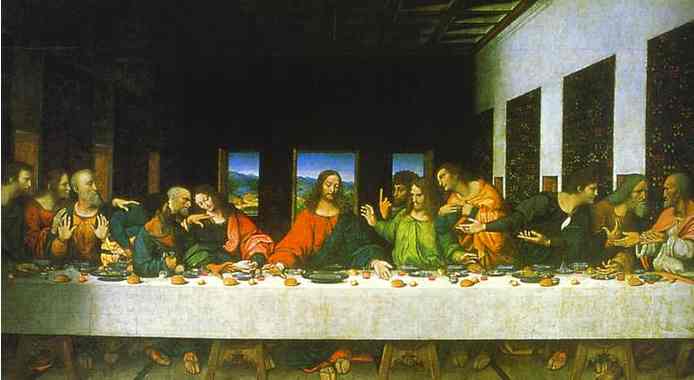
.. |
|
Tittle: The Last Supper Century: 1400s 15th century Artist: Da Vinci Movement: High renaissance location: Italy Signf: He placed Judas near christ unlike the traditional way of putting him at the end. the light source in the painting is from the windows in the MIlanese refectory.there a curve in the middle window behind christ, kind of like a halo. the prophets are divided into 4 groups of 3, and each of them have their own conversation and interaction, also Each figure conveys their own different emotions. |
| |
|
.. |
|
22-9 MASTERPIECE. Raphael. Philosophy (school of athens) Congregation of Philosophers and Scientists. Tirangle is symbolic of trinity. |
| |
|
.. |
|
Tittle: David Century: 1500s 16th century Artist: Michelangelo Movement: High renaissance Signf: In this colossal statue, Michelangelo represented David in heroic classical nudity, capturing the tension of Lysippan atheletes and the emotionalism of the Hellenistic statuary. This was the moment when he was waiting for his opponent. his rugged torso, sturdy limbs, and large hands and feet give a sense of strength to come. he abandoned, the compositions of previews davids by abruptly turning the heros head toward his foe. Michelangelo he was more interested in the depiction of emotion and feelings rather than calm, ideal beauty.
|
| |
|
.. |
|
22-21 Michelangelo, Las Judgement. Altar of the sistine Chapel. |
| |
|
.. |
|
22-22 Donato D' Angelo Bramante. Temietto, San Pietro in Montorio, Rome. Italy 1502. Considered the first high renaissance work of architecture. It resembles to greek architecture. There is a great deal of balance and harmony.
|
| |
|
.. |
|
Venician. 22-40 Titia, Venus of Urbino, 1538. Oil on canvas 3' 11" x 5'5" Titian. The venus lays in bed naked, the curtain behind her shows a division between the room, behind the curtain there are two servants showing perspective.and at the en a window. He uses as lot of red pigments in all his paintings.
|
| |
|
.. |
|
22-42 Jacopo da Pontormo. Entombment of Christ. Capponi Chapel. Santa Felicita, Florence, Italy. 152-1528. Oil on wood, 10' 3 " x 6' 4"
|
| |
|
.. |
|
22-49 Paolo veronese. Triumph of Venice. ca 1585 Oil on canvas 29' 8" x 19' . Ceiling of the hall of the Grand Council, Doge's Palace, Venice.
|
| |
|
.. |
|
22-52 Giovanni da Bologna, Abduction of the Sabine Women, Loggia dei Lanzi, Piazza della Signoria, Florence, Italy. 1579-1583. Marble, 13' 5 1/2" high. they are set within a vertical cylinder. the movement of the piece makes it mannerism
|
| |

.. |
|
23-1 Albrecht Durer, The Fall of Man (Adam and Eve) 1504. Engraving 9 7/8" x 7 5/8" Museum of Fine Arts, Boston (centennial gift of Landon T. Clay) |
| |

.. |
|
23-9 Hans Holben the younger, the French embassadors. The skull in the middle bottom is painted is a weird way. |
| |

.. |
|
23-13 Heronymus Bosch, Garden of Earthly Delights 1505-1510. Oil on wood, center panel 7' 2 5/8" x 6' 4 3/4". Museo del Prado, Madrid. it is religious in nature, it was commissioned by Henry the 3rd. Left Panel: bottom adam and eve and god in a landscape, lots of animals. it is the moment Eve was created. the right panel. lots of figures being tormented and torture, being eaten by animals. Central panel: Big orgy,scenes of couples having, some people think is about sex and procreatio |
| |
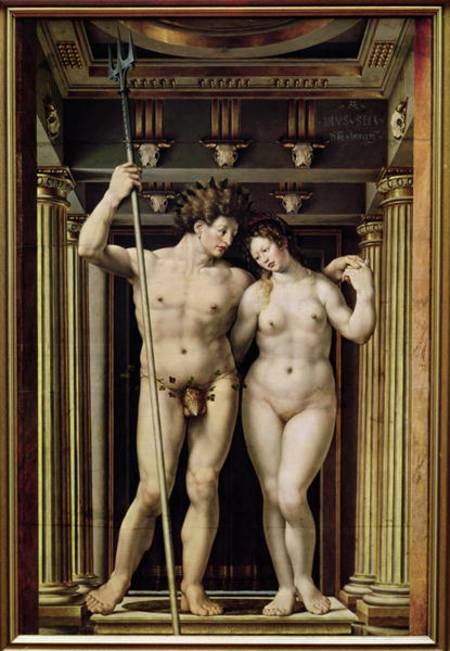
.. |
|
Tittle:
Neptune and Amphitrite
Century:
1516: 16th century
Artist:
Jan Gossaert
Movement: Mannerism
OR Venician
Location:
Gemalde-galerie, Staatliche Museen, Berlin.
Signif:
He was the first northern artist to depict the human anatomy correctly, He was
fascinated with classical antiquity. They are in a contrapposto stance.
The architectural frame is a mix of doric and ionic styles. the
figures tend to look larger than life-size.
|
| |
|
.. |
|
Tittle: Hunters in the snow.
Century: 1565: 17th century
Artist: Pieter Bruegel The Elder.
Movement:
Location: Kunthistorisches Museum, Vienna.
Signf: he draws the viewer diagonally deep into the landscape
with his mastery of line, shape and composition.
|
| |
|
|
Tittle: Hunters in the snow. Century: 1565: 17th century Artist: Pieter Bruegel The Elder. Movement: Location: Kunthistorisches Museum, Vienna. Signf: he draws the viewer diagonally deep into the landscape with his mastery of line, shape and composition. |
| |
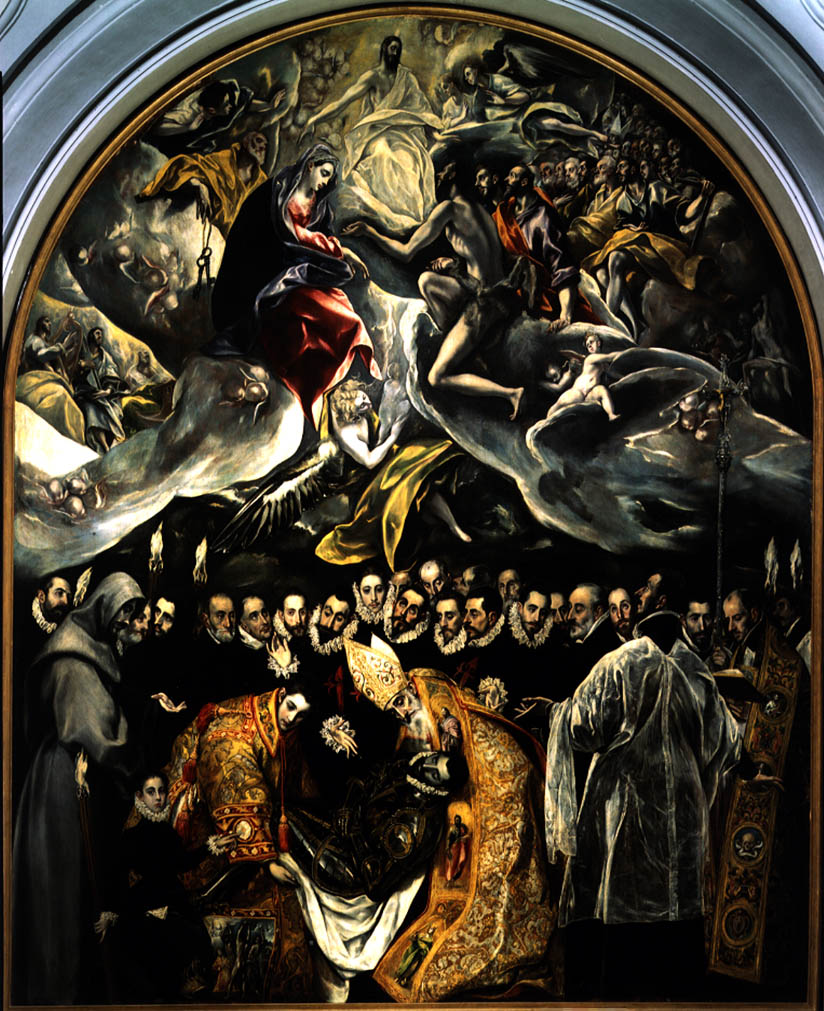
.. |
|
Tittle: Burial of Count Orgaz Century:1586: 16th century Artist: El Greco Movement: Mannerism OR Venician Location: Santo Tome, Toledo. Signf: Venician color scheme, his work incorporates manerism, his art had a lot of emotion.Based on a church legend, the legend says that when Orgaz died, Saint anthony and Saint augustine miraculously appeared from heaven and buried him. The earthly world vs the heavenly world. the earthly world is more realistic while the above looked more like figures in mannerism style, kind of El Greco's personal view of heaven. the golden color in the garment draws the viewer into thinking that is the path to heaven. the saints go down and grab him, he was taken to heaven in baby form, the baby soul is being carried by an angel to heaven. |
| |
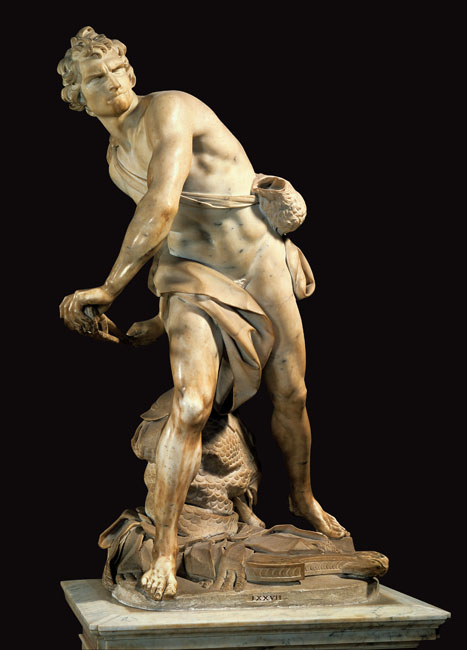
.. |
|
Tittle: David Century: 1623 : 17th century Artist: Gialorenzo Bermini Movement: Baroque Location: Galleria Borghese, Rome. Signf: Bermini was very aware of the previews Davids. Bermini's David is the instant in which he throws the rock to goliath. This is surely a baroque sculpture because of the dynamic intensity in his pose and facial expression, there's drama and tension, and motion. He has a small bag of rocks, cause he though the fight was gonna be long.
Michelangelo depicted david before the encounter, he is controlled, and more pretty. While Bermini's is more dynamic in a sense of motion and the action that is about to take place. his vision is more intense than donatello's
|
| |

.. |
|
Tittle: Ecstasy of Saint Teresa. Century:1645-1652: 17th centuryArtist: Gialorenzo BerminiMovement: BaroqueLocation: Comaro Chapel, Santa Maria della Vitoria, Rome, Italy.Signif: This is a very dramatic baroque sculpture. For this piece Bermini created sort of a dramatic theatrical scene that created tension. He used to write plays and create stage designs. The sculpture depicts saint teresa being stabbed by an angel. Her story says she used to have visions and heard voices and a persistent pain, the pain was an angel stabbing her repeatedly with an arrow and she describes how she felt intense pleasure, joy and anguish. It is a very sexual sculpture, She is pleasurably laying back on a cloud while the smile angel aims his arrow. The texture in the clouds, the rough monk's cloth, smooth skin, the rock and feathery wings. Theres a yellow window above which brings in bright golden rays which suggest heavenly presence and also it gives it dramatic lighting. |
| |

.. |
|
Tittle: Facade of San Carlo alle Quattro Fontane Century: 1665-1667: 17th century Artist: Francesco Borromini Movement: Baroque Architecture Location: Rome, Italy. Signf: He went beyond emphasizing a building's sculptural qualities. The facade is in an undulating wave motion on two levels. He emphasized three-dimensional effect with deeply recessed niches. The church has two facades. the second is a narrow bay crowned with it's own small tower. Being a good sculptor he took it beyond the limits. |
| |

.. |
|
Tittle: Plan of San Carlo all Quattro Fontane Century: 1638-1641: 17th century Artist: Francesco Barromini Movement: Baroque architecture Location: Rome Italy Sigfi: This plan is a result of a Greek cross, which is a cross with four arms of equal length, and an oval with long axis between entrance and apse. the side walls move in a wavy form that reserves the facade's motion. |
| |
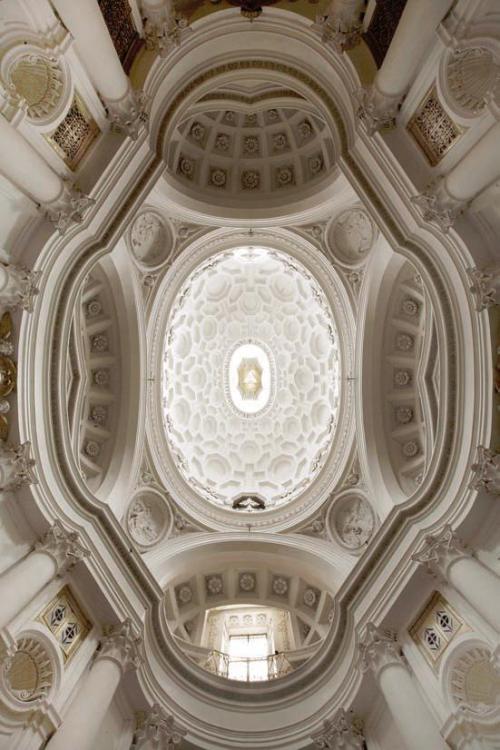
.. |
|
Tittle: Interior of San Carlo alle Quattro Fontane interior view. Century: 1638-1641: 17th century Artist: Francesco Barromini Movement: Baroque architecture Location: Rome Italy Signf: The interior is wide open, something new. An oval dome is supported by hemispherical domes. This big domes looks like its floating because of all the light coming into it. the light goes in through windows that are well hidden in the base of the dome. the circle makes the inside flow from entrance to altar. |
| |

.. |
|
Tittle: Entombment Century: 1603: 17th century Artist: Caravaggio Movement: Baroque Location: Chapel of Pietro Vilttrice, Santa atia in Vallicella, Rome, Italy Signf: Caravaggio invented In this painting Caravaggio included of his distinctive style: the plebian figure types with Nicodemus' worn scruffy face, who holds christ's legs. The severe use of lights and darks to bring out more contrast and drama into the painting. And the invitation to the viewer to participate in the scene, he does this by making low horizon line augments and close perspective. This isnt heroic, and young, Here the virgin is an old woman. They're all carrying the body of Christ into the tomb. He's illustrating an abstract idea of the body being laid out in the alter by positioning the figures on a stone lab corner which looks like its coming out. The painting was above the alter in the church. This gives the idea of transubstantiation (eucharistic bread and wine transform into the body of christ) |
| |
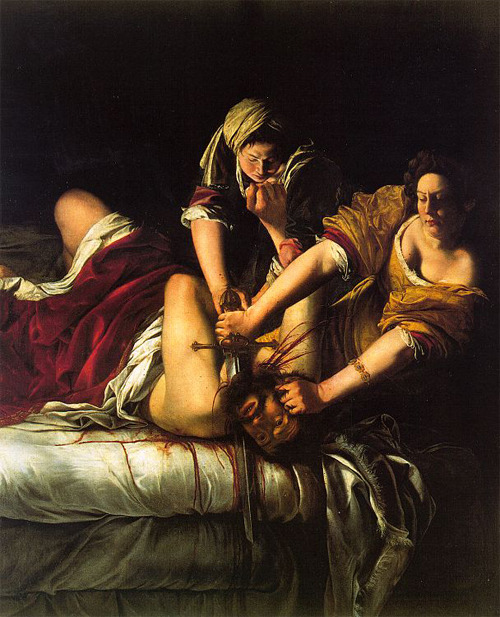
.. |
|
Tittle: Judith Slaying HolofenesCentury: 17th century, 1614-1620artist: Artemisia Gentileschi.Movement: BaroqueLocation: Galleria deglu Uffizi, Florence, Italy. Signf: She preferred themes that had to do with heroic woman figures. The story is about Judith seducing Holofenes, he invited over to his tent and while he is asleep, her and her made cut holofenes head off with a heavy sword. There is so much reality in this painting (baroque) the blood spurting everywhere and the facial expressions. Theatrical and dramatic excitement of boroque painiting. |
| |

.. |
|
Tittle: AuroraCentury: 17th century, 1613-1614Artist: Guido ReniMovement: BaroqueLocation: Casino Rospigliosi, Rome, italy
Signf: Auora is leading Apollo's chariot while the hours dance about it. He conceived a quatro riportato, which is when they paint a frame to cause illusion and be convincing. . It shows fluid motion, soft modeling, and sure composition. there was an Influence of Raphael, classical mythology, and the ultimate source to this piece were roman reliefs and coins depicting emperors in chariots.
|
| |
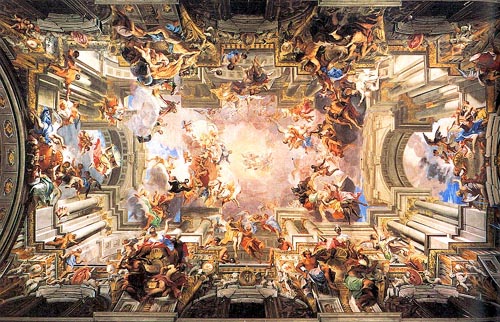
.. |
|
Tittle:
Glorification of Saint Ignatius.
Century:
1691-1694
Artist:
Fra Andrea Pozzo
Movement:
Baroque
Location:
nave of Sant' Ignazio, Rome Italy.
Signf: He
was a master of perspective. He continued this painting open to the sky
upwards, using the arquitecture, to create an illusion of heaven. Italian
boroque art depended a lot in drama and theatricality of individual images. and
illusion.
|
| |

.. |
|
Tittle: Las Meninas.
Century: 1656
Artist: Diego Velasquez
movement: Baroque
Location: Museo del Prado, Madrid
Signif: Here he showed his mastery of both form and
content. He has a self portrait standing infront of the canvas. Princess
margarita in the white dress. Her favorite dwarfs and a large dog. They all
seem to be recognizing a royal presense. Hes drawn the picture plane out
to the viewers. theres a huge amount of this space incorporated. with the guy
in the back, with the space between them. The paintings in the room are said to
be his son in laws. The images in the painting depict
the immortal gods as the source of art. The red cross he is wearing
is an indication of the Order of Santiago. The cross was added way after the
painting was done, when he was inducted into the order. The mirror in the back
shows the reflection of King Philip IV and Queen Mariana. He portrayed the
realities of image in canvas, of mirror image, of optical image, and of
two painted images. The painting is about himself in the process of the
painting them (las medinas)
|
| |
